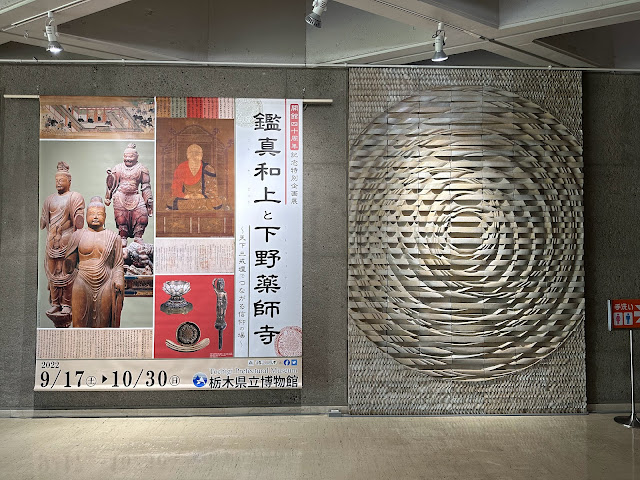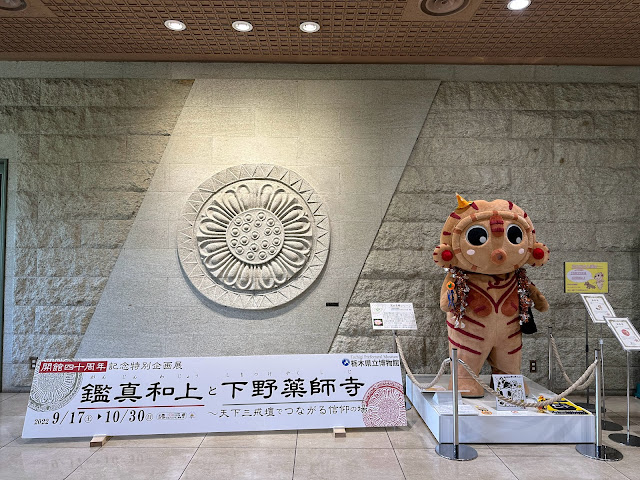栃木県立博物館の開館40周年記念特別企画展。
創建が飛鳥時代に遡るという古刹、下野薬師寺に焦点をあてて、日本に本格的な仏教を伝えた鑑真和上を始めとした、この寺にゆかりの名僧との関係も紹介した大規模な展覧会。
テーマが飛鳥時代などの古い時代ということもあって、多くの国宝や重要文化財が展示されて、とても見応えのある、重量級と言える内容だった。
栃木県の龍興寺にある、鑑真和上が将来したと伝わる仏具が展示されていた。鎌倉時代の作で勿論実物ではないが、そう信じてこれまで大切に保存されてきたということに、この地における信仰の深さを感じる。
称徳天皇と関係にあったとされて、やがてその地位を失った道鏡は、下野薬師寺に左遷されてこの地で亡くなったことを、この展覧会で初めて知った。
日光開山の勝道上人は、下野薬師寺において、鑑真和上とともに日本に渡ったイラン系ソグド人の僧、如宝の元で正式な僧になったという。
勝道上人の業績は、空海も『性霊集』の中で詳しく触れている。
忍性の推薦で金沢の称名寺の開山となった審海は、もとは下野薬師寺の僧で、鎌倉時代に下野薬師寺を最高した慈猛の弟子だったが、忍性に見出されてこの地を離れて金沢に向かった。
審海については、これまでよく知っていたので、意外な下野薬師寺との繋がりに驚かされた。
興味のあるテーマがたくさんあって、見終わった後にお腹がいっぱいになり、これからも余韻に浸りたいと思わせてくれた、そんな内容の展覧会だった。
A special exhibition commemorating the 40th anniversary of the opening of the Tochigi Prefectural Museum.
Focusing on Shimotsuke Yakushiji, an ancient temple said to date back to the Asuka period, this large-scale exhibition introduces the relationship with famous monks related to this temple, including Ganjin Wajo, who brought authentic Buddhism to Japan.
Since the theme is old times such as the Asuka period, many national treasures and important cultural properties were exhibited, and it was a very impressive and heavyweight content.
At Ryukoji Temple in Tochigi Prefecture, Buddhist altar fittings that are said to have been made by Ganjin Wajo in the future were on display. Of course, it is a work of the Kamakura period and is not the real thing.
It was at this exhibition that I learned for the first time that Dokyo, who was said to have had an affair with Emperor Shotoku and eventually lost his position, was demoted to Shimotsuke Yakushiji Temple and died there.
Shodo Shonin, the founder of Nikko, is said to have officially become a monk at Shimotsuke Yakushi-ji Temple under Nyoho, an Iranian Sogdian monk who came to Japan with Ganjin Wajo.
Kukai also mentions Shodo Shonin's achievements in detail in his "Shoryo-shu".
Shinkai, who became the founder of Shomyo-ji Temple in Kanazawa on Ninsho's recommendation, was originally a priest of Shimotsuke Yakushiji Temple and a disciple of Jimyo, who was the highest priest of Shimotsuke Yakushiji Temple during the Kamakura period, but was discovered by Ninsho.
I knew a lot about Shinkai, so I was surprised by the unexpected connection with Shimotsuke Yakushiji.
It was an exhibition with many interesting themes that left me feeling full after watching and wanting to immerse myself in the afterglow.





コメント
コメントを投稿